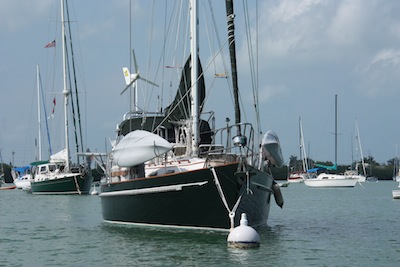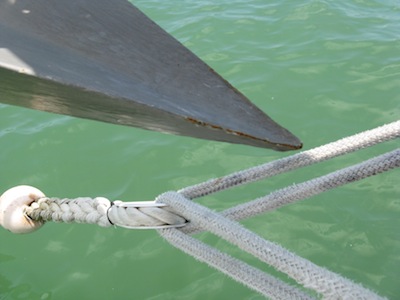Tying up to a mooring ball involves a lot more than merely being able to grab the mooring pennant with your boat hook — although I’m not very good at it yet – in the past we haven’t been anywhere with mooring balls. According to Boot Key Harbor (Marathon), there’s a CORRECT way to attach to a mooring ball.
CORRECTLY ATTACHED does NOT mean threading one line through the mooring ball pennant and back to your boat … no no no! That line will chafe for sure and is surely asking for your boat going wandering in the middle of the night if the wind pipes up … ask me how I know this!
Here’s the right way to do it and the wrong way to do it. Some mooring fields, Boot Key Harbor in Marathon/Keys is one that comes to mind, insist that you moor this way and will come around asking you to change it if you’ve done it incorrectly. They claim the incorrect way makes the line saw through not only the mooring line but their loop on the mooring ball. So to avoid damage to their mooring balls, they’re insisting on this way…
YES! Notice how there’s one line looped through the mooring pennant and back to the same side of the boat and then another on the other side. (yes, we know our anchor sometimes gets in the way and David will often turn it upside down in the anchor roller to get the tip away from the lines.)
NO NO NO! Looping a single line through a mooring pennant causes the line to act like a saw and can saw though not only the line but the pennant itself!
Also, because of the way our bow configuration is set up, when we swing, the mooring lines have a tendency to rub against either each other or the bow itself… it was worse, before David turned our anchor upside down on deck, the lines were catching on the tip of the anchor, a sure recipe for disaster.
Anyone have a mooring field that requires a different arrangement? I never knew it was so complicated! Please leave a comment and share! Cheers! Jan
















we find many of the mooring rings here in the Mediterranean are very corroded and no matter how we feed lines through there is a risk of rough edges cutting the lines. as such we have made up a special line with 5mtrs of line spliced to 1mtr of chain then the other end of the chain spliced to a further 5mtrs of line. This way we can easily feed the line & chain through the eye and leave the chain at the eye whilst both lines are made off on the boat. A further advantage is that you can throw the mid section with line over a buoy to lasso it, if you are having trouble getting onto the buoy. The chain sinks & it will wrap around the riser and hold you to the buoy whilst you make fast. Hope these ideas help. Pete Jackson
Yacht Argonauta
Firstly catching your swing mooring buoy… rather than using the boat hook to catch the marker buoy, I agree with Pete, lasso it but I use just an ordinary length if mooring line, holding an end in each hand and throwing the middle section over the buoy, this is as per the RYA method after doing this make fast and you then have plenty of time to sort your line to the buoy out. Now making fast to the buoy, in UK, we have mainly two kinds, 1) just a rusty metal ring on top of the buoy, what you do is thread your line through the ring and then back through again the both ends are tied of on the boat, if you do not thread it through the second time it will chaff for sure by doing the 2nd pass through it stops the chaffing. Set up two lines like this. The other method has rope or chain strops and these are picked up and they have a loop at the end these are then dropped over the deck cleats, and secured. What I would not do is once moored securely is to leave the anchor on the now roller, wether upsidedown or right way up. This is just incase another boat breaks free and with anchors fitted cause more damage to boats, but this is only my view and from what I gave seen. Happy Hogmanay to all..
Thanks Dave! Personally I hope we can get back to places that require us to ANCHOR, but we’ll try your “lasso” technique next time we have to try and catch a mooring ball. Cheers! Jan
Using a loop tossed over the ball is step one, or if the metal ring at the top of the ball is reachable with a boat hook I use a C.S. Johnson Grab ‘n Go Hook which is pre-attached to one end of a snubber. Step two, I use a heavy Dyneema loop that can be threaded through a ring, Dyneema is the most chafe-resistant of fibers, and by looping it through itself you stop any sawing against the ring. A nylon snubber or bridle can be tied to the loop using a Becket Hitch. I also carry my own bridle that is fitted with stainless thimbles and galvanized shackles. The bridle can only be fitted after launching the dinghy, but it is the most reliable and stops the boat from sailing around the mooring. It’s a more permanent long term solution, but if leaving the boat several days or longer it is also essential to use floats on the bridle lines. (I prefer cheap slit-foam pipe insulation held with tape or wire ties). Floats stop the nylon from sinking when they go slack, thereby preventing the lines from wrapping on the chain beneath the mooring ball, which results in chafed bridles. Leaving the mooring is a reversed process, as the bridle must be removed prior to retrieving the dinghy aboard.
BTW, to clarify, the galvanized shackles go direct to the metal ring. I would not use the Dyneema loop if using my bridle with shackles. These are alternative methods.
No discussion about mooring buoys is complete without a reference to Mainesail’s article
http://www.pbase.com/mainecruising/mooring_prep
The visuals really bring it home.
Thanks Vincent! This is more about mooring for a storm, but all the points are well taken because you never know what might pop up unexpectedly! Cheers! Jan
Thanks Jan and everyone else from newcomers to mooring balls! We’ve only used one a handful of times in our previous seven years of cruising and know we’ll be on one most of this winter!
Thanks for the moorage tips. I haven’t used a mooring ball myself since I’ve been using anchors but I’m sure I’ll use this in the future. This lasso method looks helpful.
On our 34′ Gemini catamaran, we use three lines: one to each bow cleat (port and starboard) and a slack “backup” line at center. We also use about 8″ of fire hose over each line where it passes through the ball pennant to protect against chafe.
I wonder if the Vikings knew about these methods. Follow your own lead and free your mind. Im always picked on at the marine for not making a proper knot or some other method considered standard, yet my sailboat survived Matthew without a single scratch. 80+ mph winds and 7ft surge. And I still refuse to do the curly_ q thing on my dock lines. Something about that level of conformity makes me want to puke. Do your own thing baby !
We get a lot of requests for live a boards and we don’t have that option. Would you please send me some rates and lengths and a copy of your application so I can send these to you
Hi Jane — I’m not sure what your comment’s about … but if it’s requesting information from Marathon City Marina Mooring Field, you’ll need to contact them via their link and contact info in my post. This is CommuterCruiser.com, not City Marina. Sorry! Cheers! Jan
Being permanently on a mooring during the sailing season, sailing single handed always posed a problem of can I keep the boat straight enough for me to get from the cockpit to the bow to pick up the mooring buoy. Having missed many times and lost a couple of boat hooks, I now use a system shown to me from an old sailor. I approach the buoy now at the stern and grab the buoy and pull it aboard to the stern cleat. This gives me full control of the boat and tiller until the last moment when I boat hook the buoy and pull her on board. having completed that I can then turn off the engine and put the kettle on. Whilst the kettle is boiling I then run a line from the stern to the bow block and back to the stern again, (making sure the line is on the outside off the stanchions). Tie the line onto the mooring buoy and pull the boat forward from the cockpit until I am on the mooring buoy. Fasten the lines off to the bow cleats and enjoy a cup of tea. Job done.